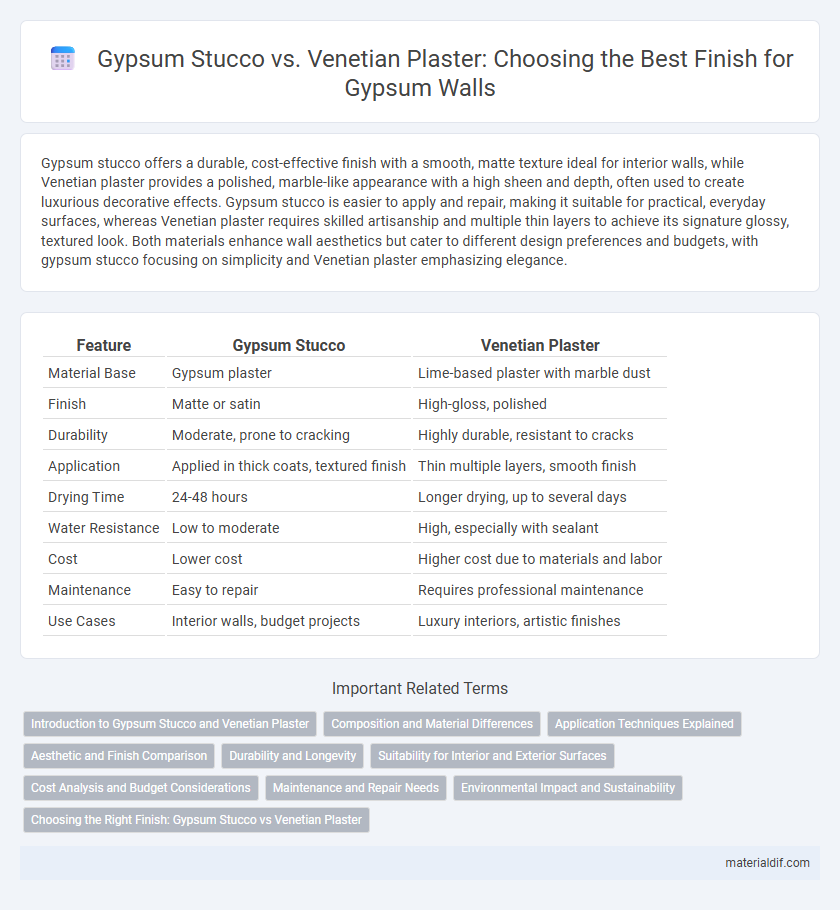Gypsum stucco offers a durable, cost-effective finish with a smooth, matte texture ideal for interior walls, while Venetian plaster provides a polished, marble-like appearance with a high sheen and depth, often used to create luxurious decorative effects. Gypsum stucco is easier to apply and repair, making it suitable for practical, everyday surfaces, whereas Venetian plaster requires skilled artisanship and multiple thin layers to achieve its signature glossy, textured look. Both materials enhance wall aesthetics but cater to different design preferences and budgets, with gypsum stucco focusing on simplicity and Venetian plaster emphasizing elegance.
Table of Comparison
| Feature | Gypsum Stucco | Venetian Plaster |
|---|---|---|
| Material Base | Gypsum plaster | Lime-based plaster with marble dust |
| Finish | Matte or satin | High-gloss, polished |
| Durability | Moderate, prone to cracking | Highly durable, resistant to cracks |
| Application | Applied in thick coats, textured finish | Thin multiple layers, smooth finish |
| Drying Time | 24-48 hours | Longer drying, up to several days |
| Water Resistance | Low to moderate | High, especially with sealant |
| Cost | Lower cost | Higher cost due to materials and labor |
| Maintenance | Easy to repair | Requires professional maintenance |
| Use Cases | Interior walls, budget projects | Luxury interiors, artistic finishes |
Introduction to Gypsum Stucco and Venetian Plaster
Gypsum stucco is a durable, gypsum-based plaster commonly used for exterior and interior wall finishes, offering a smooth surface with excellent fire resistance and moisture control. Venetian plaster, composed of polished gypsum or lime-based plasters, provides a decorative, glossy finish with subtle texture and depth, often used for luxurious interior designs. Both materials utilize gypsum for structural benefits but differ significantly in application techniques and aesthetic outcomes.
Composition and Material Differences
Gypsum stucco primarily consists of gypsum plaster combined with sand, lime, and water, creating a durable and breathable exterior finish ideal for weather resistance. Venetian plaster is made from fine slaked lime and marble dust, allowing for a smoother, polished surface with a glossy, marble-like appearance suited for interior decorative applications. The distinct compositions of gypsum stucco and Venetian plaster influence their texture, durability, and ideal usage environments.
Application Techniques Explained
Gypsum stucco is applied using a trowel in multiple coats, allowing each layer to dry before the next, creating a textured, durable surface ideal for exterior walls. Venetian plaster involves thin layers of gypsum-based plaster mixed with marble dust, which are carefully polished to achieve a smooth, glossy finish often used on interior walls. Mastery of Venetian plaster requires skillful burnishing and layering to mimic natural stone, while gypsum stucco emphasizes build-up and rough textures for weather resistance.
Aesthetic and Finish Comparison
Gypsum stucco offers a smooth, matte finish with subtle texture variations that enhance architectural details, ideal for traditional or Mediterranean aesthetics. Venetian plaster provides a polished, glossy surface with pronounced depth and texture, mimicking natural stone or marble for a luxurious, high-end look. Both materials create durable, decorative walls, but Venetian plaster excels in visual sophistication while gypsum stucco emphasizes understated elegance.
Durability and Longevity
Gypsum stucco typically offers moderate durability with resistance to fire and moisture but may require frequent maintenance in high-humidity environments compared to Venetian plaster. Venetian plaster, made from slaked lime and marble dust, provides exceptional longevity and durability through its dense, hard surface that resists cracking and peeling. The natural breathability of Venetian plaster also enhances its lifespan by preventing moisture accumulation, making it a superior choice for long-term interior wall finishing.
Suitability for Interior and Exterior Surfaces
Gypsum stucco is highly suitable for interior surfaces due to its smooth finish and moisture resistance, offering durability without compromising aesthetic appeal. Venetian plaster, composed of lime and marble dust, excels in interior applications where decorative, polished finishes are desired but is less appropriate for exterior use because it lacks weather resistance. For exterior surfaces, gypsum stucco is preferred due to its robustness and ability to withstand varying environmental conditions.
Cost Analysis and Budget Considerations
Gypsum stucco typically offers a lower initial cost compared to Venetian plaster, making it a budget-friendly choice for large surface applications. Venetian plaster involves more labor-intensive techniques and higher-grade materials, which significantly increase overall project expenses. Budget considerations should also include long-term maintenance costs, with Venetian plaster generally requiring less frequent repairs due to its durability and resistance to moisture.
Maintenance and Repair Needs
Gypsum stucco requires regular sealing and patching to prevent moisture damage and cracks, making maintenance relatively straightforward but essential for longevity. Venetian plaster, composed of multiple thin layers of lime-based plaster, is more durable and resistant to moisture but demands skilled artisans for repairs to maintain its polished finish. Both materials benefit from professional upkeep, but Venetian plaster offers superior durability with less frequent maintenance compared to gypsum stucco.
Environmental Impact and Sustainability
Gypsum stucco offers significant environmental benefits due to its natural abundance, low toxicity, and recyclability, making it a sustainable choice for eco-friendly construction. Venetian plaster, while aesthetically superior, typically involves lime and synthetic additives that increase its environmental footprint through higher energy consumption and limited biodegradability. Gypsum stucco's lower embodied carbon and renewable raw materials contribute to its advantage in sustainable building practices and reducing ecological impact.
Choosing the Right Finish: Gypsum Stucco vs Venetian Plaster
Gypsum stucco offers a durable, cost-effective finish with a matte texture that suits both interior and exterior surfaces, providing excellent moisture resistance and fire retardancy. Venetian plaster delivers a luxurious, high-gloss appearance with depth and subtle color variations, ideal for upscale interiors requiring a polished, marble-like aesthetic. Selecting the right finish depends on budget, desired texture, and application environment, with gypsum stucco favored for practicality and Venetian plaster sought for decorative elegance.
Gypsum stucco vs Venetian plaster Infographic

 materialdif.com
materialdif.com